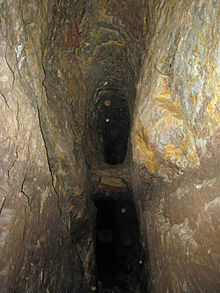old man

As old man (also the old man or old man, plural: old man ) are dismantled and abandoned in the mining industry , filled with backfill or broken by mining methods . Locked-off pits are also referred to as old men .
Origin of the term
In the Upper Harz mining industry , the miners of the Middle Ages have been called old men since the beginning of modern times . Miners from earlier times were also called this in other mining areas. Later the term came up for the tunnels created by the medieval miners . If the miners came across a mine during their work, in which an ancestor had already worked, they said: "The old man has been there."
In the Sauerland mining area , the miners wrote the expression old man on paper when they came across an old, dismantled part of the deposit during their work. The miners described the process of breaking through into this old part of the deposit as "striking into the old man". Were minerals from the old already processed area herausgeklaubt or a collapsed old area again aufgewältigt , the miners called it "the old man build".
The term old man was later used throughout the mining industry to refer to all parts of the deposits that were mined .
Processes in the old man
If the expansion of a mine has been stolen and the overburden is no longer supported, it gradually begins to collapse. It is difficult to predict when the mountains will collapse and how these erosion processes will take place. In addition to the mountain masses that are breaking in, there are already deliberately added rock material . Remnants of the mined mineral also remain in the old man. The old man is no longer ventilated as planned . In areas that are no longer ventilated, depending on the local conditions, gas accumulates. In coal mining, methane can accumulate in the cavities . Gradually the cavity itself fills with rock. The mountain materials are compressed and sintered by the mountain pressure . It can happen that parts of the cavity are not filled; pit water can penetrate into these remaining cavities and collect there.
hazards
Since the hanging wall in the old man can break in at any time, staying there is life-threatening. There is also danger from bad weather . Such areas, if they are still accessible, are marked with a St. Andrew's cross and closed off. Despite all these dangers, 21 miners fled to an old man in an ore mine in Lengede in October 1963 and were able to stay there for 14 days until eleven of them were rescued. This became known as the Lengede Miracle .
If remains of coal remains in the old man during hard coal mining , this can, under certain conditions, lead to a fire in the old man. If the miner comes across an old man at work who has accumulated water, he can be in great danger, depending on the amount of water accumulated. Due to the gas accumulation in the old man, there is a risk of explosion, depending on the composition of the gas mixture. On the surface of the earth, collapsed old men lead to subsidence or day breaks and consequently to mountain damage .
If the Old Man has been properly mapped, miners can bypass or schedule it. It becomes dangerous if there are no correct drawings, for example in mining from prehistoric times or in mines whose documents have not been preserved.
literature
- Ernst-Ulrich Reuther: Introduction to mining. 1st edition, Verlag Glückauf GmbH, Essen 1982, ISBN 3-7739-0390-1 .
Individual evidence
- ^ A b c Heinrich Veith: German mountain dictionary with evidence. Published by Wilhelm Gottlieb Korn, Breslau 1871.
- ^ Walter Bischoff , Heinz Bramann, Westfälische Berggewerkschaftskasse Bochum: The small mining dictionary. 7th edition, Verlag Glückauf GmbH, Essen, 1988, ISBN 3-7739-0501-7 .
- ↑ Explanation of terms relating to mining in the Harz Mountains (accessed on April 25, 2012).
- ^ A b Carl Friedrich Richter: Latest mountain and hut lexicon . First volume, Kleefeldsche Buchhandlung, Leipzig 1805.
- ↑ Country girls and old men ( page no longer available , search in web archives ) Info: The link was automatically marked as defective. Please check the link according to the instructions and then remove this notice. (accessed on April 25, 2012; PDF; 1.4 MB).
- ↑ Johann Cristoph Stößel, Johann David Stößel (Ed.): Mineral and Bergwerkslexikon . Chemnitz 1743.
- ↑ Carl Hartmann (Ed.): Concise dictionary of the mountain, hut and Saltwork science of mineralogy and geognosy. First volume, second completely revised edition, Bernhard Friedrich Voigt bookstore, Weimar 1859.
- ^ Wilhelm Leo: Textbook of mining science. Printed and published by G Basse, Quedlinburg 1861.
- ↑ Dieter D. Genske: Engineering geology basics and application . Springer Verlag, Berlin Heidelberg 2006, ISBN 978-3-540-25756-1 .
- ↑ Carl von Scheuchenstuel : IDIOTICON the Austrian mining and metallurgy language . kk court bookseller Wilhelm Braumüller, Vienna 1856.
- ↑ a b c d Carl Hartmann: Concise dictionary of mineralogy, mining, metallurgy and salt works. First section A to K, printed and published by Bernhard Friedrich Voigt, Ilmenau 1825.
- ^ A b Franz Ritter von Rziha: Schlagende Wetter. Lecture from February 10, 1886.
- ↑ Explanatory dictionary of the technical terms and foreign words that occur in mining in metallurgy and in salt works and technical articulations that occur in salt works. Falkenberg'schen Buchhandlung publishing house, Burgsteinfurt 1869.
- ↑ a b Der Spiegel of November 13, 1963: From the crypt (accessed on April 25, 2012.)
- ↑ Pit Old Man. In: Mineralienatlas - Fossilatlas. Stefan Schorn, accessed on May 31, 2019 .
- ↑ Johann Gottfried Jugel (Ed.): Geometria Subterranea. New improved edition, bookseller Johann Paul Kraus, Vienna 1773.
- ↑ District government Arnsberg: Measures against explosion hazards from the old man (accessed on April 25, 2012).
